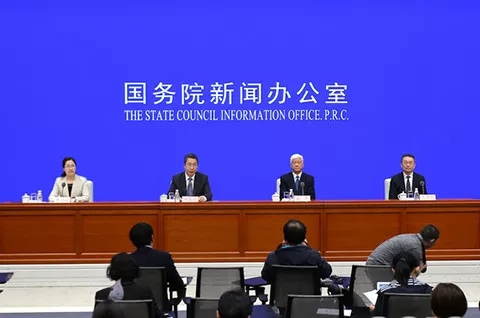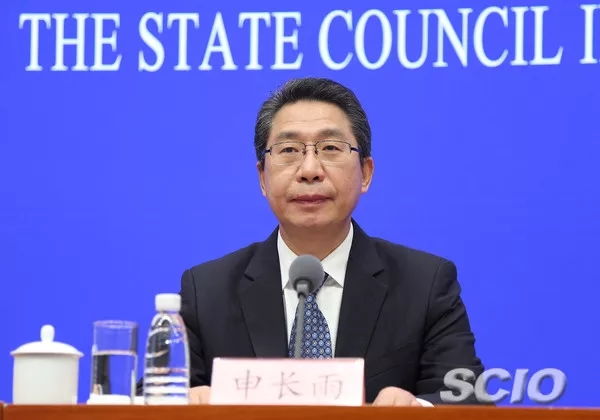SCIO:China's efforts in intellectual property protection

The State Council Information Office of China (SCIO) holds a press conference on China's efforts in intellectual property protection on April 28, 2019.
Shou Xiaoli:
Ladies and gentlemen, good morning. Welcome to the press conference. April 26 this year was the 19th World Intellectual Property Day. China's protection of intellectual property has received great public attention. Today, we have invited Mr. Shen Changyu, director of the National Intellectual Property Administration, to introduce China's efforts to protect intellectual property in 2018, and answer some of your questions. Also with us today are Mr. Zhao Gang, vice director of the National Intellectual Property Administration, and Mr. Yu Cike, director of the Copyright Administration under the Publicity Department of the Communist Party of China (CPC) Central Committee.
Now, Mr. Shen will give us a brief introduction.

Shen Changyu:
Thank you, Ms. Shou. Good morning, everyone. First, I wish to thank the State Council Information Office and all our friends from the press for having shown understanding and support for the work on intellectual property rights over all these years. General Secretary Xi Jinping delivered a keynote speech at the opening ceremony of the Second Belt and Road Forum for International Cooperation in Beijing, April 26, 2019. In his speech, Xi announced a series of major reforms and opening-up measures that China will take, stressing that China will intensify its efforts to enhance international cooperation in the protection of intellectual property. According to Xi, China will spare no effort to foster a business environment that respects the value of knowledge, fully improve the legal framework for protecting intellectual property and step up law enforcement. It will also enhance protection of the lawful rights and interests of foreign intellectual property owners, stop forced technology transfers, improve protection of trade secrets, and crack down hard on violations of intellectual property in accordance with the law. Xi's remarks further convey China's stance and attitude toward its efforts to fully protect intellectual property in accordance with the law to the international community. His remarks also provide principles and guidance for the development of China's intellectual property rights, which will be fully studied, grasped and put into practice.
Now, I will give you a brief introduction on the development of China's intellectual property rights in 2018.
In 2018, the CPC Central Committee and State Council elevated IPR protection to an level of importance that is unprecedented. General Secretary Xi Jinping emphasized in his keynote speech at the opening ceremony of the Boao Forum for Asia Annual Conference 2018 that IPR protection is the centerpiece of the system for improving property rights protection, and it would provide the biggest boost to enhancing the competitiveness of the Chinese economy. The State Council has made a series of important decisions on IPR protection. Over the past year, the departments of the Chinese government and local authorities have worked to implement a series of important decisions on IPR by the CPC Central Committee and State Council, so as to move faster to transform China into a country that is strong on intellectual property rights, and to ensure new progress can be made in all works.
First, we made stable efforts to transform China into a country that is strong on intellectual property rights. We earnestly implemented last year's plan on deepening the national IPR strategy and building China into a country that is strong on IPR. We started to formulate the Outline of the National Intellectual Property Strategy for 2035. We completed an evaluation of the implementation of the current version of the Outline of the National Intellectual Property Strategy as well as a mid-term evaluation on the plan for IPR protection and utilization in the 13th Five-year Plan Period (2016-2020). We also restructured the National Intellectual Property Administration, which is now also responsible for the administrative adjudication of patents, trademarks and geographical indications, while affairs related to copyrights are now administered by the Publicity Department of the Communist Party of China (CPC) Central Committee. The quality and efficiency of IPR examination continues to rise: The examination process for trademark registration has been cut to six months, and for high-quality patents the process has been cut by 10%. A total of 5.86 billion yuan in patent application fees was exempted or reduced over the past year. A national appeal court for IPR cases was inaugurated at China's Supreme People's Court so as to better strengthen IPR protection and management.
Second, the protection of intellectual property rights has been comprehensively strengthened. The draft amendment to the Patent Law passed the first review of the Standing Committee of the National People's Congress. The draft established a punitive compensation system for infringement and has greatly increased infringement costs. We have been actively promoting the revision of the Copyright Law and initiated the revision of the Trademark Law. The Regulation on Patent Agency and the Regulations on the Protection of New Varieties of Plants were revised. The Action Plan for the "Internet Plus" Intellectual Property Protection was formulated. A total of 38 ministries and commissions have carried out joint punishment for serious discredit conducts in the field of intellectual property (patents). The administrative law enforcement of intellectual property rights continued to strengthen, with 77,000 patent administrative law enforcement cases being handled, up 15.9% year-over-year. Altogether 31,000 trademark violation cases were investigated and handled, with a total case value of 550 million yuan. 2,500 infringement and piracy cases were filed and investigated. 3.77 million pieces of pirated products were seized, and 1.85 million infringing links were deleted. Customs at all levels detained altogether 44,550 batches of infringing goods. The number of infringing goods was 23.18 million, with a total worth of 200 million yuan. The courts of all levels received 301,279 first instance IPR cases, up 41.13% year-over-year. The public security organs of all levels registered nearly 28,000 cases of infringement and counterfeit crimes. Of them, 19,000 cases were solved, and 28,000 suspects were arrested. The case value amounts to 9.87 billion yuan. The procuratorates of all levels approved the arrest of more than 5,600 people who were involved in more than 3,300 IPR infringement cases. More than 4,400 cases involving more than 8,300 people were brought to public prosecution.
Third, the amount and quality of intellectual property creations have risen. We further implement the patent quality improvement project and trademark brand strategy, and severely crack down on non-normal patent applications and trademark preemptive registration and hoarding behaviors. The number of domestic invention patents (excluding Hong Kong, Macao, and Taiwan) reached 1.6 million pieces, an increase of 18.1% year-on-year. The ownership number of invention patents per 10,000 population reached 11.5 pieces, and the number of Patent Cooperation Treaty (PCT) international patent applications received and processed was 55,000, a year-on-year increase of 9%. The number of valid domestic trademark registrations reached 18.05 million, a year-on-year increase of 32.8%. The number of applications for international trademarks registration according to the Madrid Agreement Concerning the International Registration of Marks was 6,594, a year-on-year increase of 37.1%. A total of 2,380 geographical indication products and 4,867 registered geographical indication trademarks were approved. A total of 1,990 new varieties of agricultural plants and 405 new varieties of forestry plants were awarded, an increase of 34% and 153.1% respectively. The number of registrations of works and computer software copyrights reached 2.35 million and 1.1 million, an increase of 17.48% and 48.22% respectively. According to the Global Innovation Index 2018 Report published by the World Intellectual Property Organization (WIPO), China ranked 17th in the world and became the only middle-income economy to enter the top 20.
Fourth, the use of IPR has been greatly improved and is now more efficient. We have improved the national public service platform for the trading of IPR and launched IPR trading systems in 16 major cities. We have rolled out a set of measures to use IPR to promote the innovative development of private enterprises. The fund raised by pledging patents and trademarks totaled 122.4 billion yuan, up 12.3% year-over-year. We issued 40 golden awards to patents and external designs, and 20 golden awards to copyrights. We checked 8,179 enterprises for their use of geographic indication in products with a total output value of 1 trillion yuan. From 2016 to 2018, the export of IPR royalties reached US$11.51 billion, achieving the goal set in the 13th Five-Year Plan ahead of schedule.
Fifth, we have deepened the international cooperation on intellectual property rights. We hosted the 2018 High-level Conference on Intellectual Property for Countries along the Belt and Road, took an active part in multilateral activities under the framework of the World Intellectual Property Organization (WIPO) and the World Trade Organization. We have also enhanced cooperation with international organizations such as the International Union for the Protection of New Varieties of Plants, and improved international rules regarding intellectual property rights. Together with the WIPO, we established a Technology and Innovation Support Center. We tried to promote an earlier implementation of the Beijing Treaty on Audiovisual Performances, as 23 countries have either ratified or joined the treaty. We held the Global IP Protection and Innovation Development Conference during the first China International Import Expo. The number of China's partners in the Patent Prosecution Highway (PPH) program has increased to 28. China's valid patents have also been officially registered in Cambodia, and the results of our patent examination are recognized in Laos.
The above is the development of China's intellectual property rights in 2018. Now I'm ready to take your questions. Thank you.






